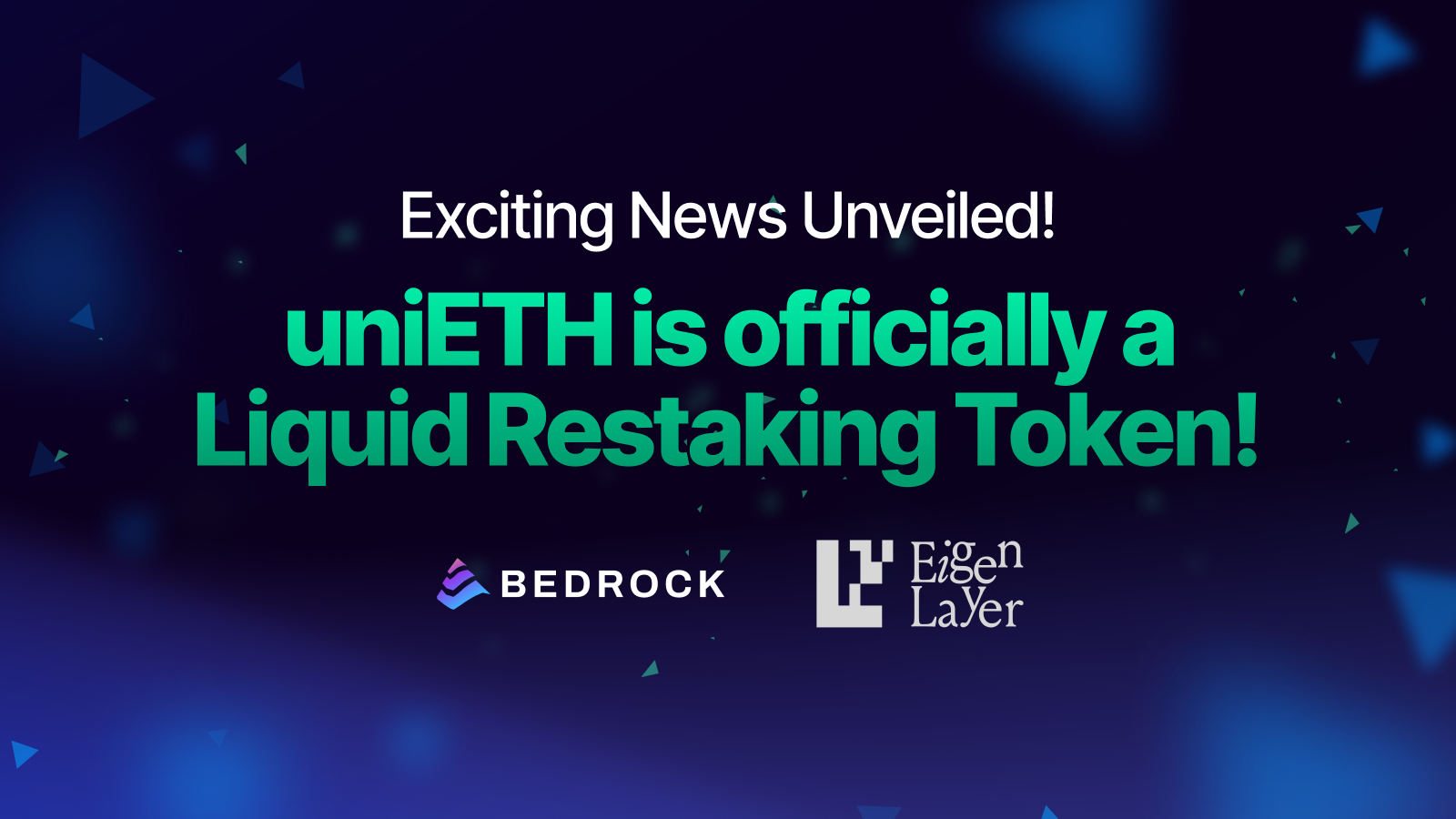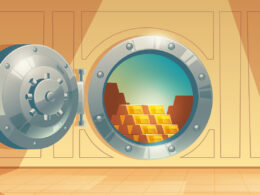We are proud to announce that uniETH is now officially listed as an LRT, allowing users to earn heightened rewards consisting of base staking rewards, Bedrock Diamonds and EigenLayer points. Restaked ETH on Bedrock will be deployed through EigenLayer with a restaking delegation module for additional yield and secured through the use of EigenPod Manager, making it one of the best options for ETH restaking.
This is the latest in a series of upgrades implemented to Bedrock since its inception in March 2023. Bedrock has come a long way since then, achieving a TVL of over $36M at the time of writing. We started with liquid staking on Ethereum with uniETH, and have since expanded to become the first-ever liquid staking protocol on the DePIN-leader – IoTeX network – with uniIOTX. We have also integrated Wallet Connect to make liquid staking with institutional-grade security easier than ever before, and we’ve made some amazing partnerships with the likes of Amber Group, SushiSwap, Coin98 and more. Now, we are proud to bring restaking to the Bedrock community with EigenLayer.
The Future of Ethereum Staking
Ethereum’s Merge in 2021 increased the popularity of staking by a large margin, with 24% of ETH’s total supply staked today. This resulted in the rise of liquid staking that allowed people to stake ETH without running their own validators, and without the need to meet Ethereum’s 32 ETH minimum. With the Dencun upgrade underway, even more changes will be coming to the staking domain on Ethereum. Today, one of the most promising innovations in the staking space is restaking as developed by EigenLayer.
Restaking and LRTs: The Latest in Staking Evolution
In summary, restaking on EigenLayer allows idle staked ETH to be used to secure protocols built on top of Ethereum, resulting in a more robust and secure ecosystem and greater rewards for ETH stakers.
Liquid Restaking Tokens, commonly referred to as LRTs, are an innovative solution that have arisen from the restaking concept. Similar to liquid staking tokens (LSTs), these tokens address the challenges of traditional staking methods, primarily the issue of asset illiquidity. LRTs offer users the ability to maintain flexibility with their investments while still participating in restaking activities and earning the higher rewards associated with restaking.
Bedrock’s Upgrade From LST to LRT
We are thrilled to share that Bedrock’s smart contract has been upgraded, converting Bedrock from a mere LST to an LRT that can earn users greater rewards while maintaining no change to the user experience and keeping the process seamless. Users may continue to simply mint uniETH on Bedrock’s platform, and the smart contract will automatically restake your staked ETH on EigenLayer. This ensures that additional rewards are captured while your experience remains simple and streamlined. Do note that unstaking remains the same on EigenLayer with a 7-day cooling period.
Additional Rewards: Introducing Bedrock Diamonds
In addition to the base staking and heightened restaking rewards, users will also earn EigenLayer points and Bedrock Diamonds.
Bedrock Diamonds are a reward system for early adopters and loyal users of Bedrock. Stakers will earn 1 Diamond per hour for each uniETH minted and held in their wallet. Early adopters and LP providers will also receive 3x and 2x boosters respectively. In the near future, we will be launching a referral program to give users even more ways to accumulate Diamonds, so keep a lookout for that!
Additional Information on Restaking
Restaking brings staked ETH to protocols on Ethereum. This enhances security on dApps built on Ethereum by tapping into pooled security and further promotes decentralization by establishing individual trust networks. This will also bring about permissionless innovation and free-market governance for the Ethereum ecosystem, initiatives that we are eager to promote.
Restaking Features and Benefits
Other than promoting the robustness and security of the Ethereum ecosystem, a key advantage of holding LRTs is the continuous earning of staking rewards. The underlying assets represented by LRTs are still engaged in the staking process, thereby generating rewards. This feature enables LRT holders to potentially earn more passive income than regular staking or liquid staking, adding an attractive layer to their investment strategy. Moreover, the enhanced liquidity and flexibility offered by LRTs allow users to diversify their investment approaches, balancing between earning potential and maintaining access to their assets.
Risks of Restaking
Despite the above benefits, restaking presents a unique set of risks. Primarily, there is an increased slashing risk, where stakers face potential penalties from additional protocols involved in the restaking process. This collective risk is compounded by the complexity of restaking mechanisms, operational dependencies on restaking platforms, and the performance of validators across multiple protocols.
Additionally, restakers must navigate market and liquidity risks, as the value of tokens received can fluctuate with market conditions. Moreover, the evolving regulatory landscape adds another layer of consideration, impacting the operation of restaking platforms and the distribution of rewards. These factors collectively underscore the need for a comprehensive understanding and careful assessment of restaking providers before participating.
Managing Restaking Risks With Bedrock
In light of these risks, Bedrock has implemented several security measures that you may review on Bedrock’s documentation page. In summary, the Bedrock team is highly experienced in running blockchain validators, with experience in running validators on over 30 blockchains. Furthermore, Bedrock is focusing on optimizing the parameters of restaking which include the scoring of AVS Operators and TVL caps per AVS service.
Plans to implement a security deposit mechanism are also in the works, where AVS operators will be required to deposit into the Bedrock community fund. If implemented, this fund will be used to reimburse uniETH holders in the event of any slashing incidents in the future.
Additionally, Bedrock utilizes the EigenPod Manager, a smart contract deployed by Bedrock to manage the EigenPod, which is the withdrawal credential in the restaking process. Through the smart contract, Bedrock offers enhanced security and reduces centralization risk. Any changes or upgrades to the smart contract are subjected to rigorous testing and auditing as if it were a new contract. This process is critical for maintaining the security and functionality of the EigenPod Manager. This approach enhances security and addresses concerns about centralization or other potential risks for uniETH holders.
The EigenPod Manager is a crucial component of Bedrock’s non-custodial restaking approach, offering enhanced security, flexibility, and transparency for uniETH holders interested in restaking.
In Closing
Bedrock’s transition from LST to LRT represents a significant evolution in the realm of staking, aligning with the latest trends in the Ethereum ecosystem. The introduction of uniETH as an LRT marks a pivotal moment, offering users heightened rewards, consisting of Bedrock Diamonds and EigenLayer points, through a seamless and familiar process. Bedrock’s commitment to optimizing the restaking experience, coupled with robust security measures with its EigenPod Manager, assures users of both enhanced rewards and peace of mind.
As we step into a new era of decentralized finance, Bedrock continues to pave the way with innovative solutions, reinforcing the strength and versatility of the Ethereum blockchain. For those looking to dive into the future of staking, Bedrock’s platform offers a compelling and secure gateway, promising both growth and security in the ever-evolving crypto landscape.









